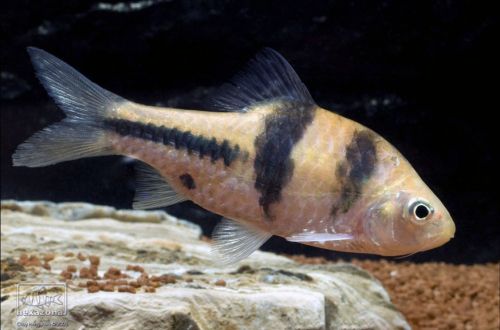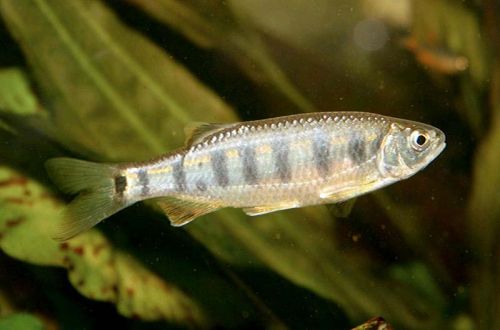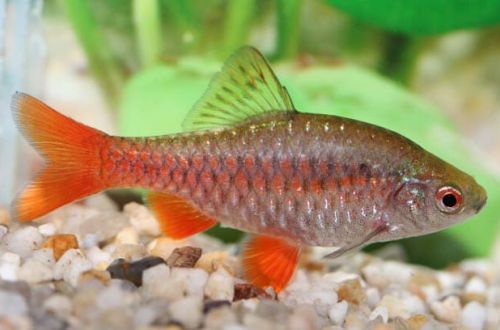
Barbus cross
The cross barb, scientific name Puntius lateristriga, belongs to the Cyprinidae family. A rather large and very mobile schooling fish, which spends most of its life in constant motion. Given the size of an adult, a large aquarium is required for successful maintenance, which is perhaps the only serious drawback of this species of Barbs.

Contents
Habitat
The homeland of the species is Southeast Asia, the territory of the modern states of Indonesia, Thailand and numerous islands (Java, Sumatra) and archipelagos of the South China Sea. Predominantly inhabits forest clear streams, often found in small pools that form at the base of waterfalls. The substrate consists of smooth stones and boulders of various sizes, coarse sand or gravel with rich aquatic vegetation and numerous tree fragments (roots, branches, snags, etc.). The cross barb has also been found in peat bogs, the high concentration of tannin coloring these waters a rich dark brown, reminiscent of strong tea.
Description
A fairly large fish, reaching a length of 15 cm, females have a heavy massive body in comparison with more elegant males. The main coloration is light with a characteristic pattern of several vertical and horizontal stripes, the silhouette of which resembles a cross. With age, the pattern becomes less distinct.
Food
In the wild, they consume everything they can find: diatoms, organic detritus, small insects, worms, crustaceans and other zooplankton. In a home aquarium, the diet should consist of a variety of components, which are based on live or frozen food (bloodworms, daphnia, brine shrimp), as well as some dry food (flakes, granules), which contain herbal supplements.
Feed 2-3 times a day in the amount eaten in five minutes, uneaten leftovers should be removed in a timely manner.
Maintenance and care, arrangement of the aquarium
Optimal conditions are achieved in a spacious aquarium with a design reminiscent of the natural habitat of the Cross Barb, i.e. a rocky substrate with areas of dense vegetation and shelters in the form of large snags, roots and tree branches.
Permissible water parameters range from slightly acidic to neutral with low salinity. Read more about the pH and dGH values and how to change them in the “Hydrochemical composition of water” section.
The standard set of equipment consists of filtration, aeration, heating and lighting systems. Since the fish is sensitive to water quality and the content of organic waste, a prerequisite for successful keeping is the installation of a productive filter and a weekly renewal of part of the water in a volume of 30 to 50%. In addition, filters provide the necessary movement of water – the internal flow.
Behavior and Compatibility
The cross barb is highly active and is considered a very noisy neighbor for other fish. Compatible only with large robust species of similar size. Keep at least 6 individuals in a flock, with a smaller number, aggression is possible. Intolerance to other fish can also be caused by a lack of free space in a small aquarium, this primarily applies to males.
Breeding / breeding
Fish are able to give birth in a common aquarium, without the need to create special conditions. However, in this case, the survival rate of the fry will be at an extremely low level, since the parents are prone to eating their own eggs and the young that have appeared.
High breeding results can be achieved in a separate tank, which is a medium-sized aquarium of 50-60 liters. The design uses a substrate of large pebbles or a layer of decorative balls with a diameter of 1 cm or more. Barbs scatter their eggs in open water and, falling on such a substrate, they roll into the space between the pebbles / balls, thereby becoming inaccessible to their parents. As protection, a finely meshed mesh located on the ground or a dense cover of low herbaceous plants is also used. The choice is up to the aquarist. The equipment uses a simple sponge filter, heater and aerator, no lighting system is required, external light is sufficient, which comes from the room / room. The water parameters (pH, dGH, temperature) must be identical to the water from the community tank.
The mating season for this species of fish does not have a clearly defined seasonality, so you should pay attention to external signs. If the female or several females noticeably rounded, and the males showed a more saturated body color, then offspring should be expected. Future parents are placed in a separate tank and are expected to spawn. During this time, the fish should be fed mainly meat products, as well as daily removal of organic waste and water changes.
When the eggs are laid, the fish are returned back, the fry appear after 24–36 hours, and already on the 3rd day they begin to swim freely in search of food. Feed with specialized food for fry from pet stores or microorganisms – Artemia nauplii, ciliates, etc.
Fish diseases
A hardy and unpretentious species, health problems in the vast majority of cases are associated with inappropriate or poor conditions of detention. An aquarium with a well-established biological system is the best prevention against all fish diseases. Read more about symptoms and treatments in the Aquarium Fish Diseases section.





